How to find ideas for articles, blog posts, videos, live broadcasts, podcast episodes, opt-in incentives, courses, products and more!
Do you struggle to get ideas for content that people really want to consume that you can turn into videos, social media, free reports to give away in exchange for someone’s email address, live broadcasts, products or courses?
You see, here's a problem: millions of pieces of content are created every day.
But most people aren't even the least bit interested in consuming that content.
If you want to build your business, one key is to create content that people actually want to read, watch, give you their email to get access to, and even buy!
How about if I show you a single place that is full of hundreds of millions of ideas?
Not only that, it also shows you exactly how popular those ideas are (in other words, how interested people are in actually consuming that content.)
What is this amazing source?
It's a little site you may have heard of, called YouTube.com.
In this article I’m going to show you eight different ways you can use YouTube as a place to get and research ideas, so you will never have to struggle with what to create again.
Start By Accessing YouTube Using Incognito Mode
I recommend you “play along” with me as you read, doing some of your own searches so you can see the value of this for your own business.
Start by opening up a new Incognito Window in your browser to do this. Doing this, assuming you don’t log into YouTube when you get there, enables you to see a fairly generic set of search results, less influenced by your online history.
To open up an incognito, start by clicking on the three vertical dots in the upper right corner of your browser (I’m assuming your on a desktop here) and choosing “New incognito window” from the dropdown bar. This is a screenshot from Chrome, but each of the modern browsers now has a similar function. Google “incognito mode + [your favorite browser]” if you need help.
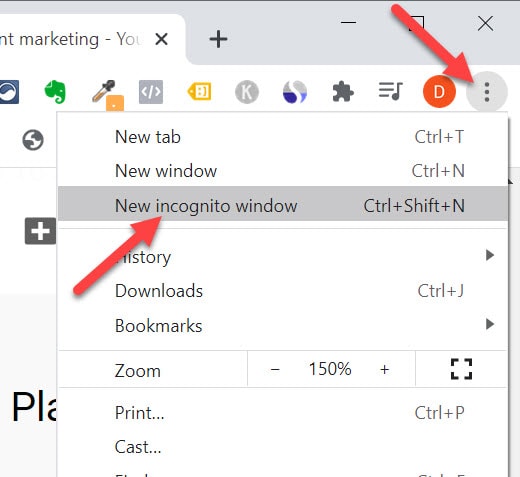
Then, in that incognito window go to YouTube.com

Now that you’re there, do a search for your main interest. For this article, I’ll search for the term content marketing.

When I say main interest, I mean that you should search for the generic term that describes what you focus on: meditation, fitness, leadership, aardvark raising, whatever. Starting there gives you an overall impression of viewer and creator interest in your space.
If you haven’t yet figured out what your main interest is that’s all right, for now. Choose something that you like, and let's go see if there's anybody in the world who's interested in it.
How To Read The Search Results
If I do a search for the term content marketing on YouTube, I get the following videos (keep in mind that your search results will probably be different):

As you look at these, you get several vital pieces of information. You get the title of the video, the YouTube channels where it’s posted, viewership numbers that show you how many people have been watched it, and how long ago this video was published.
You can see that “What is Content Marketing?” has gotten 56,000 views for Jessica Stansberry in 3 years.

And “The Beginner’s Guide to Content Marketing” in a year has gotten 56,000 views for Neil Patel.
That’s how you get numbers to help you gauge the potential impact of what you create in this particular category.
Clearly there are people that are interested in these videos. Maybe not as many as there are in a more generally-applicable category like weight loss, but this shows me that there is interest in this area.
How do you know whether a particular topic has enough consumer interest to pursue? I’d look for at least 5 videos in the top 20 results of a search on that generic category search term that have gotten at least 50,000 views in a year. Hopefully more, lots more videos that qualify under that standard and lots higher view counts.
Now let's go from observer mode into ideation mode to start putting the idea power of YouTube to work to help you get ideas for your own content. This takes a tiny bit of creativity, but not much.
Strategy #1: Copy Their Title
Since you got these results by searching on your generic category search term, my guess is that many of the titles you’re seeing in these results are ones that you could make yourself.
I recommend you do. And that you literally copy their title.
And you do know, that copyright law specifically states that titles can’t be copyrighted. Legally, you have the exact same rights as Jessica Stansberry to create a video, blog post, live broadcast or webinar called “What is Content Marketing.” And you have the same rights as Neil Patel does to create one titled “The Beginner’s Guide To Content Marketing.”
But just because something’s legal doesn’t necessarily make it ethical, right? Here’s how I handle the ethics of this. First off, I’m not going to create content called “The Grapes of Wrath” or “The Hunt For Red October.” Those titles are too well known and clearly were created by someone else. But more generic, lesser known titles, like virtually anything you see on YouTube, are absolutely fair game.
Secondly, when I see a title I really want to use myself, I don’t watch that video. That way the content I create won’t be duplicative of theirs, because I haven’t seen their content and don’t know what they said. Thus, nobody can accuse me of copying what they created.
That’s an easy way to pass both the ethical and the moral test.
Strategy #2: Adapt Their Title To Your Category
Let’s start with the first video in the list “What Is Content Marketing?” From that title, it’s clear that this video will be a 50,000-foot view of the entire subject.
To capitalize on this we use the “Adapt Their Title To Your Category Strategy” which is where you simply take the subject they used in their video and replace it with your own.
You can, and should, create a What is [Your Topic] video for your interest category. Not only will that give you a chance to appear in the listings for that generic search, but it will be a great video to feature on your website to demonstrate your expertise in the category and to give your visitors your unique take on the subject.
But you can go beyond that – and create What is [Your Topic] for each of the major sub-topics within your niche. You could easily create 10-50 different what is videos, giving overviews and perspectives to the newbies within your space.
Let’s try another one. How about “The Beginner’s Guide To Content Marketing In 2020.” This is another great generic piece of content you should create: The Beginner’s Guide to [That Subject] in [Year]. You can create a beginner’s guide to just about anything, and again, should consider doing it for each of the sub-topics within your niche.
Or how about this one: “How to Create Content.” Again, you can do a “How to [Your Topic]” for your main topic and a bunch of other sub-topics underneath it.
There are literally hundreds of examples of base titles you can adapt to your category we could mention here.
I recommend you go through the top 30 or so results from your generic category search, looking for titles you can adapt to your category.
And, by the way, you don’t have to use this strategy just on the videos that come up on a search for your category. You can put in almost any generic search and see similar adaptation ideas coming up there, so keep your eyes open for new ideas whenever you’re hanging out on YouTube.
Strategy #3: Replace Some Words To Make It More Specific
Here's another video that’s ranking highly for the content marketing term:

This is a great example of an opportunity to replace a word or a few of them to get totally new topics.
For example, taking “Content Marketing Strategy That Gets Leads And Sales” we could replace “Leads and Sales” with just leads so it becomes “Content Marketing Strategy That Gets Leads” an even more focused video on how to get leads with content marketing.
Or we could take out leads and make it “Content Marketing Strategy That Gets Sales.” As you can see, just by taking out a couple of words we get a totally new content creation opportunity.
Or we can start replacing words so your title becomes “Content Marketing Strategy That Gets Instagram Followers,” or “Content Marketing Strategy That Gets Search Engine Traffic,” or “Content Marketing Strategy That Gets Walk-in Traffic To Your Retail Store.”
Or, what if we replaced a different set of words creating “Social Media Strategy That Gets Leads,” “Search Engine Optimization Strategy That Gets Leads,” or “Webinar Strategies To Gets Leads.”
The power of thinking this way and using this strategy is that you can quickly turn just about any title into one that will apply to you and your business, and oftentimes create a title that will be more specific so it will be even more attractive to your audience than the original one was.
Strategy #4: Add A Date Into A Title
Let me ask you a question. How often do you choose to watch a video with the current year in the title over one that doesn’t have a year in it?
There’s just something about “The Ultimate Content Marketing Strategy for 2021” that just sounds more appealing than “The Ultimate Content Marketing Strategy.”
Another great idea for content creation is to simply apply “for [year]” to any of the video titles you find in YouTube. That way you’re giving people the impression that your information is more applicable, accurate and time-sensitive than the other options they can consume.
Plus, this strategy allows you to go through the top search results, find everything that contains the prior year’s date in it and create your own with the current year’s date in it. (“The Ultimate Content Marketing Strategy for 2020” is just screaming for someone to create “The Ultimate Content Marketing Strategy for 2021”)
And, by the way, this can also be applied to periods of less than a year. You could create “The Ultimate Content Marketing Strategy for the Second Half of 2021” or publish “The Ultimate Content Marketing Strategy for 2022” in the latter part of 2021, giving people the feeling you’re helping them set themselves up for the upcoming year.
Of course, this strategy does create a deadline – the year’s going to run out and the very date that once made it extra valuable will penalize it the next year. But that’s just a great excuse to do a new piece of content for the next year, picking and choosing only the ones that did well for you in the past year, ignoring the rest.
Strategy #5: Use YouTube’s Auto-complete Tool
To use this strategy, simply start typing in your search term, but don’t click return. YouTube will automatically give you a list of suggestions of terms you can choose from.
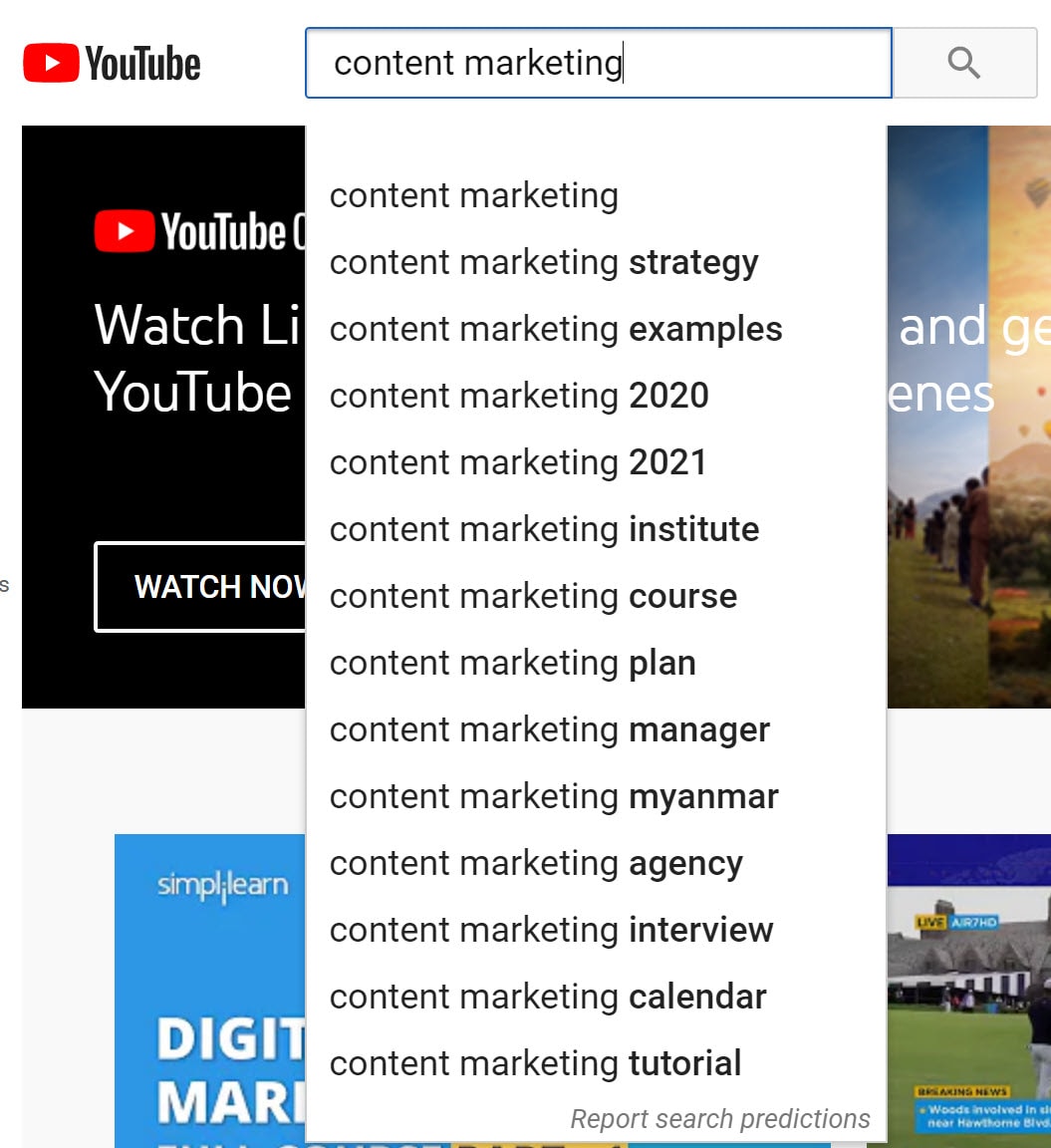
It is commonly believed that this list is made up of terms that are frequently searched for based on what you’ve already typed.
Not only is this list valuable from an idea-generating standpoint, it’s also opening up some visibility to the additional data that YouTube is gathering from it’s billions of daily searches. It shows you the popular searches in that topic area.
In this case, you would probably be well served by creating content not just about content marketing, but you probably should consider creating additional content that addresses content marketing strategy, give them some examples of good content marketing, show them how to create a content marketing plan, how to work with a content marketing manager or agency, how to create a content calendar, and hey, you might as well throw in some content marketing tutorials while you’re at it.
Just using this one strategy can give you enough work to do for a few months!
Strategy #6: Drill Down Into YouTube Suggested Terms
Now that we’ve got YouTubes list of suggested search terms, let’s do a search on each of them to see what they can reveal to us.
To do this, search on each of the terms in the suggested list from the previous strategy, and apply each of strategies 1-5 on them. Look for titles that you can straight-up copy, that you can adapt to your category, that you can replace a word or two to get a much more specific piece of content, and where you can add a date to give it extra punch.
Looking at the first auto-complete term in the search for “content marketing,” we can do a search for “content marketing strategy”, without hitting return and get a number of excellent content ideas you should consider if you’re working in this topic area:

There’s gold in that list: “Content marketing strategy for ecommerce,” “Content marketing strategy for startups,” “Content marketing strategy goals,” “Content marketing strategy steps,” and “Content marketing strategy for seo” are all topics someone who’s trying to teach content marketing should consider creating.
The important thing you should recognize is none of these rich topics came up in the original search on “content marketing.” That’s why it’s incredibly valuable to drill down into the other subtopic areas.
It’s also important to recognize that these more specific topics probably have lower levels of competition, so you’re more likely to have your content appear in the various search engines if it’s more specific (“Content marketing strategy for ecommerce,”) than a generic piece of content about “What is content marketing.”
And, while we’re on the topic of drilling down, let’s drill down a different way:
Strategy #7: Drill Down Into Other Peoples’ Channels
So far we’ve developed ideas based on generic category searches. The next step is to start looking into other channels that specialize in your category to see what they’re doing.
To do this, I like to scan through the results and look for channels that have several different videos showing up in the results. When that happens, it’s a pretty good indication that they’re focusing on this subject and might have some good ideas we could consider.
As I scroll down in the search results for “content marketing,” I keep seeing videos created by Kimberly Ann Jimenez. Not only does she have a definite look (and clearly gets YouTube marketing,) she’s also showing up 4 times as I’m scrolling down:
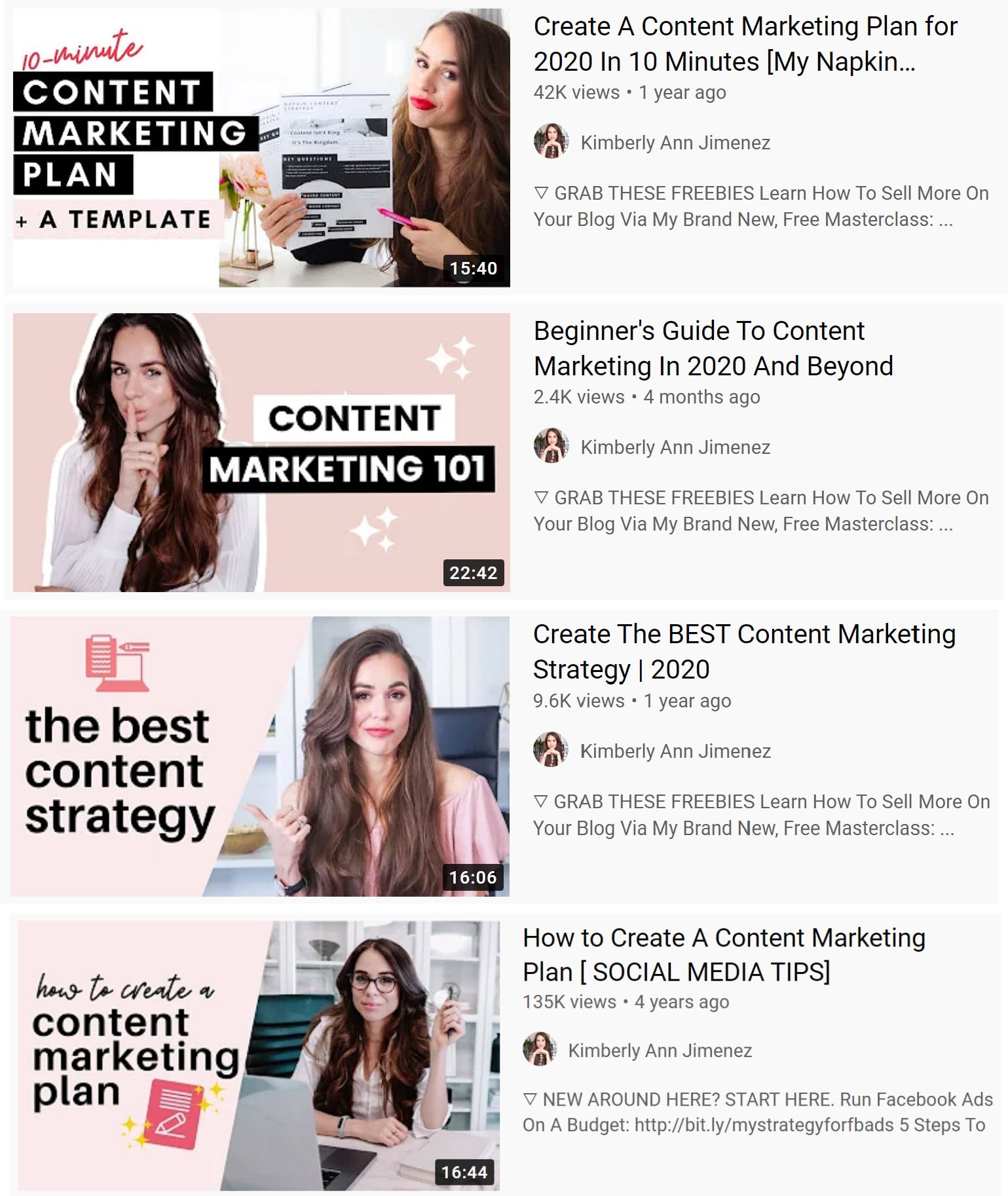
Let’s check out her channel by clicking on her name in one of the video descriptions. https://www.youtube.com/user/KimberlyAnnJimenez
She’s got a good-looking channel with a bunch of good videos.
Whenever I’m doing this stage of ideation, I like to scroll down and look at their playlist titles to see if they have one or more that are directly applicable to what I’m looking for. Sure enough, Kimberly Ann has a playlist titled Learn Content Marketing.
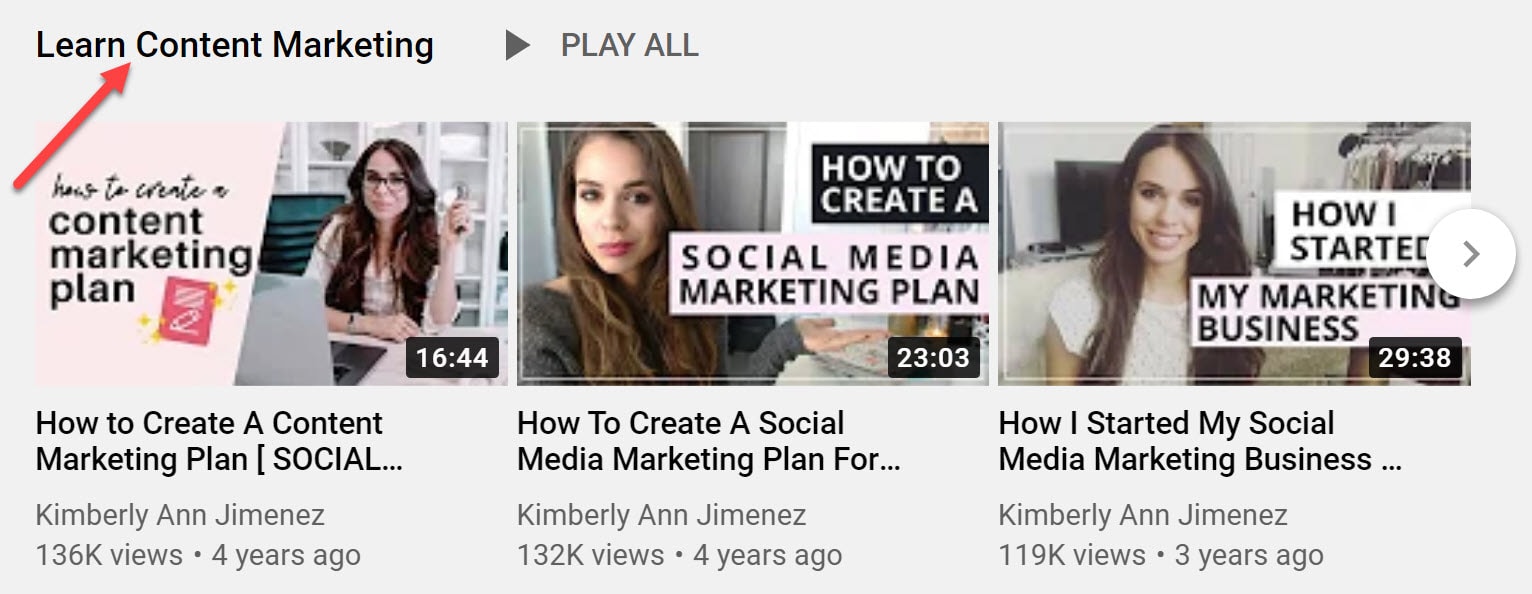
When I click on the title of that playlist (“Learn Content Marketing”) I get a page with 47 different videos on it that’s been viewed 4,135 times. Now, while that’s not huge in YouTube terms, that’s more than four thousand people viewing this playlist, who have seen that she’s got 47 videos on that subject and by now have probably concluded that she knows a little bit about content marketing. 🙂

But the channel’s home page is not the only place where playlists are shown. Smart YouTubers create multiple playlists. If you click on the Playlists link at the top of the channel, you’ll see all the playlists they’ve created. Kimberly Ann’s created thirty of them:

Remember, anybody can add almost anybody else’s YouTube videos to their playlist, so playlists can be a rich source of ideas.
How can we use this data to build our business?
I invite you to consider that each time you find a playlist about your particular subject area, you’ve just found a list of a bunch of different topics that you could use as idea starters to create your own content around.
Now, repeat this same exercise with 5, 10, or 20 different channels that serve your target market, grabbing the list of titles and view counts from each of them.
Put them all into a spreadsheet. Then go through and eliminate duplicates.
By the time you’re done, you’ll have a list of at least a couple of hundred topics that are proven to be of interest to your audience.
Let’s say you created one of them a week. That’s literally years’ worth of content.
And my guess, is that by the time you get done creating and marketing all that content, people will start to see you as someone who knows a ton about your industry…
Someone they’d be willing to pay to get the help they need.
You may want to start by putting them all into a spreadsheet, then sort by view count, and go down from there.
Please don’t choose one channel and use their exact titles. Those titles are ideas; subject areas to create content around. Create your own title for each piece of content that best reflects what’s in that article, video or podcast episode.
While you’re at it don’t even watch their videos so you don’t copy their content. Remember, what we’re doing here is building a list of topics proven to work with people interested in this subject area.
That content could be videos, live broadcasts, emails, blog posts, etc.
And don’t forget that there are some amazing opt-in incentives (lead magnets), a bunch of webinars, a year’s worth of podcast episodes, and 3-5 courses in there too.
But we’re not done yet:
Strategy #8: Check Out The Related Videos
YouTube makes its money showing you ads, so they want you to watch more videos, lots more videos.
So, with every video, they also show you related videos.
You see it at the end of many YouTube videos where they automatically go onto the next video with that circle around the play button that never gives me enough time to hit cancel, so I end up watching a never-ending stream of videos:
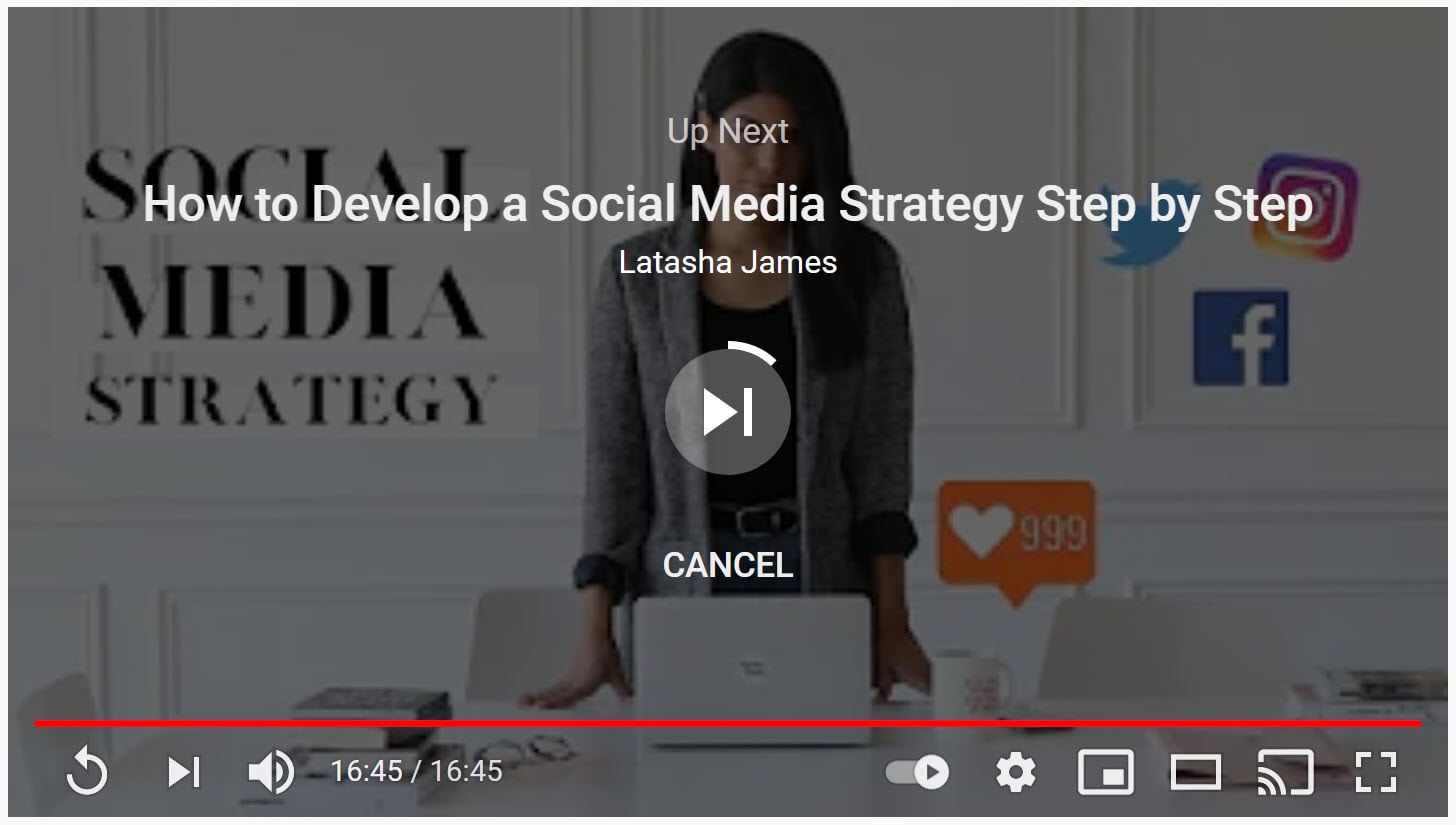
But the part that becomes valuable for us in this exercise is the list of videos shown down the side.

Since that list endlessly scrolls, you can see “a whole bunch” (that’s a technical term) of videos that YouTube’s algorithm sees as being related to the one you’re watching. (We can rest assured that there is some serious number crunching happening in that list.) They know that x people have clicked on that particular related video when it’s shown in the 3rd spot down for the video being shown.
Why is this valuable? Because it enables you to go beyond the obvious connections that your mind can think of, and starts applying the power of big data to show what people are actually doing when they watch a video on your topic.
My recommendation: take advantage of all that data, look at the videos that are related to the key ones you’ve created (and those you plan to create) and create videos about those same topics even if they don’t feel totally on brand.
The audience for that particular video is indicating that they’re interested in more information on the related videos topic. Why shouldn’t that content be yours?
Start Looking At YouTube Differently
When you look at YouTube as a source of ideas, as opposed to a source of blowing three hours watching funny cat videos everything starts to change for you.
In fact, I recommend you do exactly the opposite of most people. Don’t even watch all these videos, just go to YouTube to find topics that have numbers that tell you whether it is a good idea or not.
And, start taking advantage of all of YouTube’s data-crunching to start seeing inter-relationships between different videos and different topics that perhaps you haven’t been seeing on your own.
I like to look at a page on YouTube and ask “how can I turn this into something else? How can I use this data to grow my business? What does this data show my audience needs? What fits for my brand? Where should I go next?”
Ask Yourself – Is This Single-Post Worthy or Course-Worthy
And finally, I like to apply a filter to these ideas. I continuously ask myself “Is This Single-Post Worthy or Course-Worthy?
Is this idea I’ve just gotten of the quality and rich enough that I should use it to create a blog post, a single video, a single live, a single webinar, or is it so rich that I should be looking at creating a whole course?
And, while you’re thinking that, keep in mind that a course can be a $1997 20-hour fully immersive program, or it could be a $47 mini-course with a couple of hours of content designed to bring people into your world then perhaps sell them a higher dollar course or program later on.
Try applying that filter to the ideas you’re generating.
Don't Give Into The Trap Of "I Don't Have Any Ideas!"
One of the things I struggle with as I work with entrepreneurs is when I hear people say that they can't figure out any good ideas to create an opt-in incentive about, to create videos about, to write articles about, and even to create a course or program about.
YouTube can help solve that, by giving you access to hundreds of thousands of other peoples’ ideas and numbers that show how well that idea is resonating with the marketplace.
I’ve shown you 8 different ways to use this tool to get those ideas and that data. Now, it’s up to you.
Are you going to use this data to get ideas to improve your life…
Or is YouTube just going to be a fun place to blow a few hours.
It’s up to you.
Just go do this stuff!



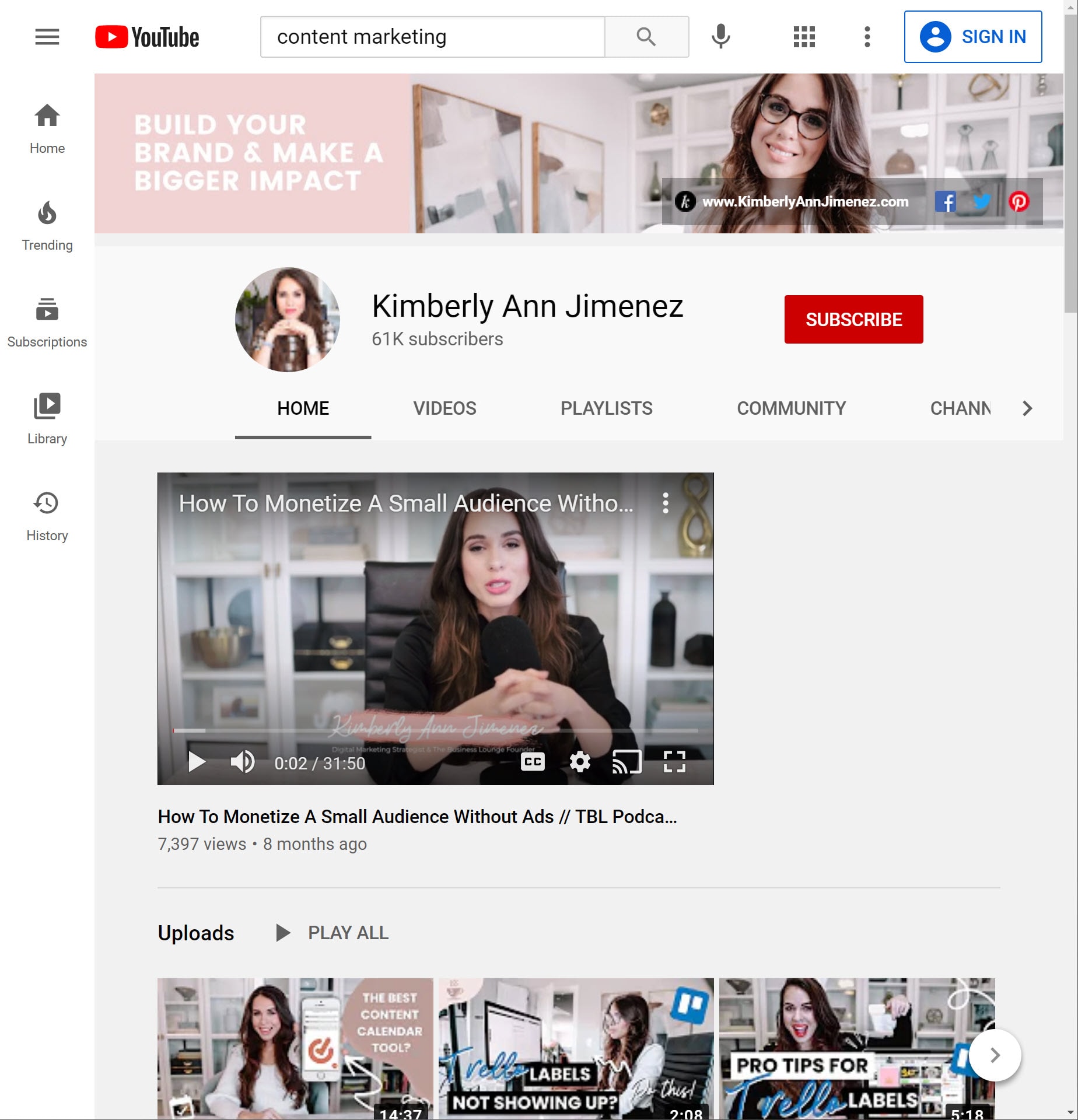
Great Stuff Don.
Brett